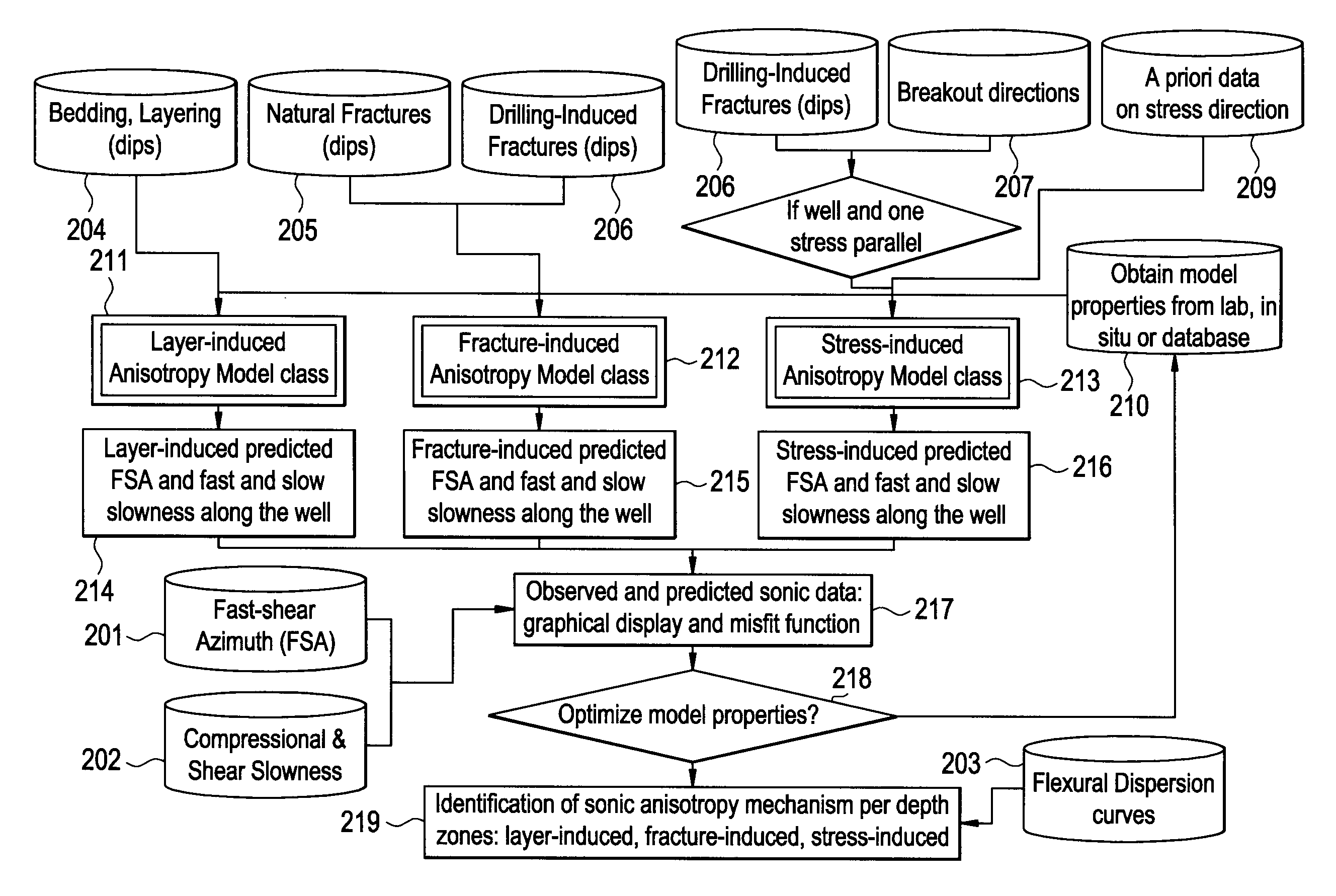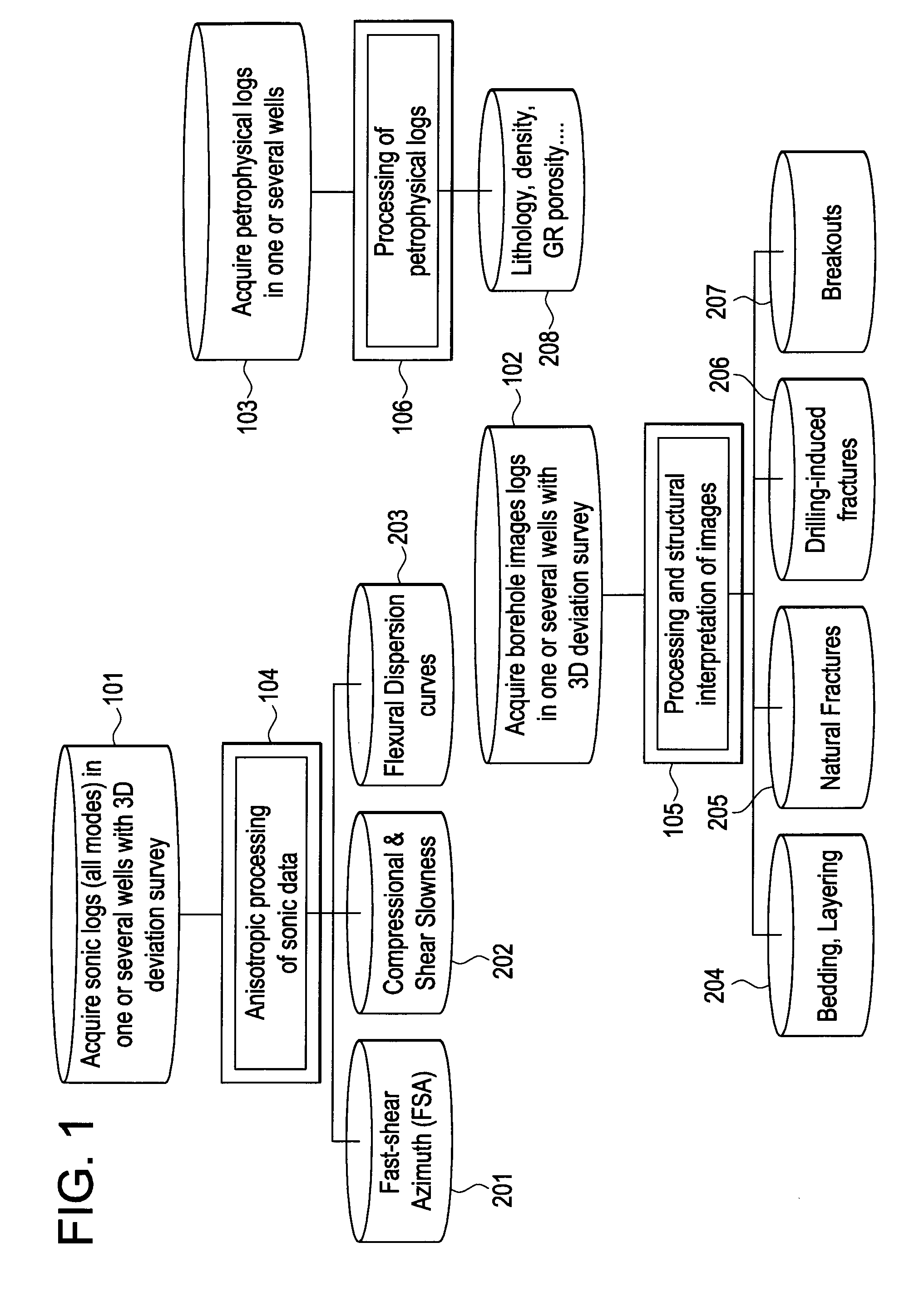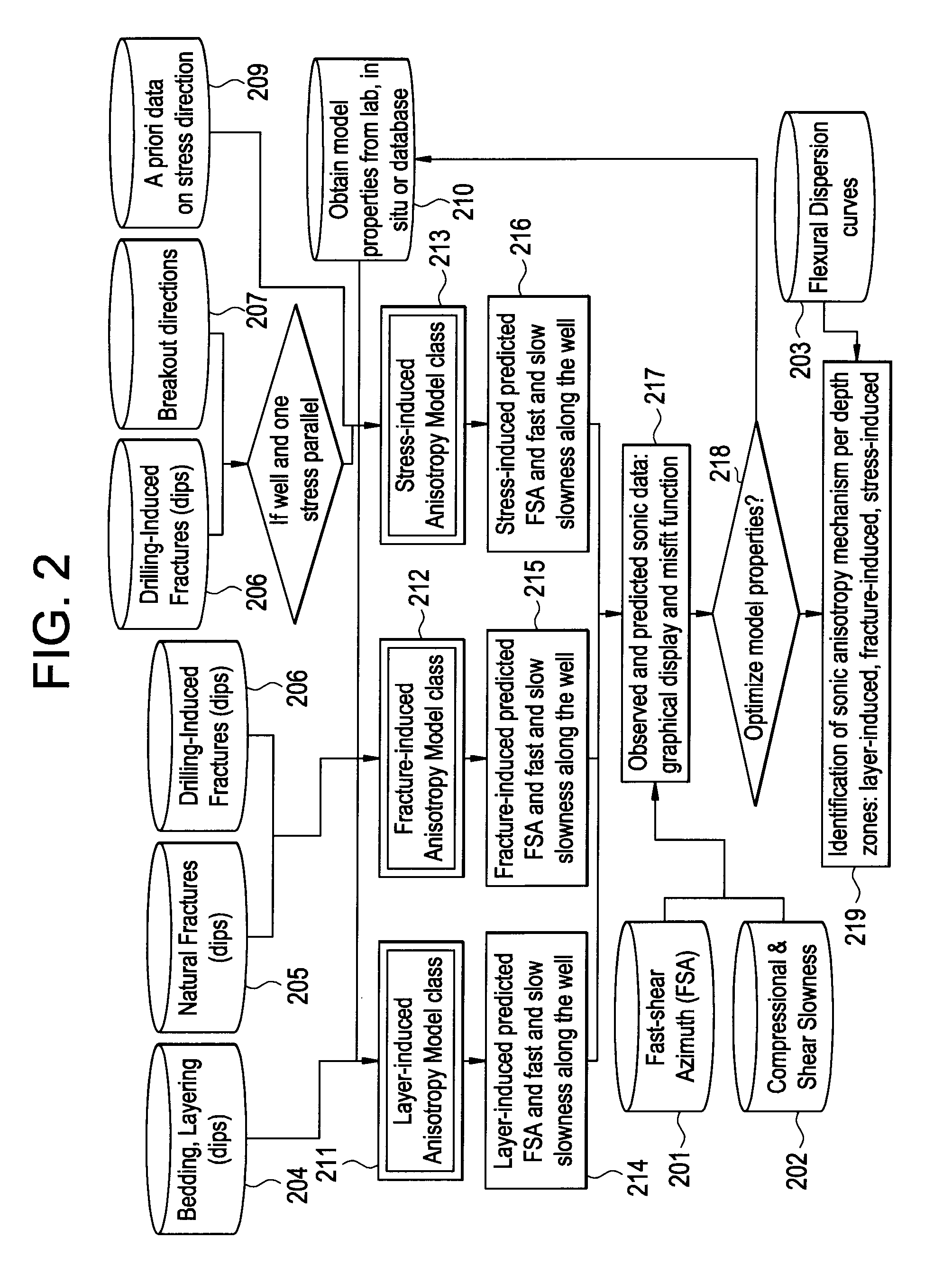[0052]According to at least one embodiment of the invention, the invention includes an apparatus for estimating stress characteristics of formations. The apparatus comprises of: a memory operable to store image data and a sonic anisotropy data associated with one or more borehole wherein the one or more borehole is one of vertical or deviated; circuitry operable to employ the sonic anisotropy data to estimate fast shear direction (FSA) so as to extract FSA observed data; circuitry operable to employ computing the FSA from forward modeling, wherein the forward modeling utilizes a first deviatoric stress tensor to extract FSA predicted data; circuitry operable to employ computing FSA misfit from the difference between the FSA observed data and the FSA predicted data to obtain a computed FSA misfit that relates to the first deviatoric stress tensor; circuitry operable to determine if the computed FSA misfit is equal to or less than a defined value, then stores the computed FSA misfit and the first deviatoric stress tensor in the memory, repeat computing FSA misfit using another deviatoric stress tensor such that a different deviatoric stress tensor is used for each repeat, until one of all or multiple predefined deviatoric stress tensors have been applied while computing the FSA from forward modeling, then store the repeated computed FSA misfit along with storing the respective deviatoric stress tensor; and circuitry operable to selecting the smallest stored computed misfit from the group consisting of the stored computed FSA misfit and their respective deviatoric stress tensor, one or more other stored computed misfit and their respective deviatoric stress tensor or some combination thereof, to determine a final estimated deviatoric stress tensor whereby the final estimated deviatoric stress tensor is used for reservoir activities.
[0053]According to aspects of the invention, the invention may include the first deviatoric stress tensor including principal stress directions and deviatoric stress factor R. Further, the one or more other stored computed misfit can be one of computed borehole break direction (BOD) misfit or computed tensile fracture direction (TFD) misfit. Further still, the circuitry can be operable for computing BOD misfit and TFD misfit by: (a) circuitry operable for employing the image data to identify borehole failure type and orientation, wherein the image data includes one of BOD, TFD or both so as to extract one of BOD observed data, TFD observed data, or both; (b) computing one of the BOD, TFD or both from forward modeling, wherein the forward modeling utilizes the first deviatoric stress tensor to extract one of BOD predicted data, TFD predicted data or both; (c) computing BOD misfit from the difference between the BOD observed data and the BOD predicted data to obtain the computed BOD misfit which relates to the first deviatoric stress tensor; (d) circuitry operable to determine if the computed BOD misfit is equal to or less than a second defined value, then store the computed BOD misfit and the first deviatoric stress tensor, repeat computing BOD misfit using another deviatoric stress tensor such that a different deviatoric stress tensor is used for each repeat, until one of all or multiple predefined deviatoric stress tensors have been applied while computing the BOD from forward modeling, then store the repeated computed BOD misfit along with storing the respective deviatoric stress tensor; (e) computing TFD misfit from the difference between the TFD observed data and the TFD predicted data to obtain the computed TFD misfit which relates to the first deviatoric stress tensor; and (f) if the computed TFD misfit is equal to or less than a third defined value, then store the computed TFD misfit and the first deviatoric stress tensor, repeat computing TFD misfit using another deviatoric stress tensor such that a different deviatoric stress tensor is used for each repeat, until one of all or multiple predefined deviatoric stress tensors have been applied while computing the FSA from forward modeling, then store the repeated computed FSA misfit along with storing the respective deviatoric stress tensor. It is possible the apparatus may further include replacing the first deviatoric stress tensor with: (1) having a given deviatoric stress tensor in a principal stress frame (PSF), such that the given deviatoric stress tensor is transformed into a north-east vertical frame (NEV); (2) transforming the given deviatoric stress tensor from the NEV frame to a top of the borehole frame (TOH) using previously stored borehole orientation data; and (3) using analytical expressions for stresses at one or more borehole wall for an arbitrary orientation of the borehole (Kirsch-Fairhurst Stress Model), relative to a far-field in situ stress tensor provides computing a direction of BOD for any one of the one or more borehole orientation as an angle for which a tangential stress reaches a maximum value, whereby the TFD is provided by an angle for which the tangential stress reaches a minimum value. Further still, replacing the Kirsch-Fairhurst Stress Model with: at least one other stress model that provides for stresses at the borehole wall for an arbitrary orientation of the borehole relative to the far-field stress. Further, replacing the first deviatoric stress tensor with: (1) having a given deviatoric stress tensor in a principal stress frame (PSF); (2) computing an effective stiffness tensor (Cijkl) as a function of stress using a stress-induced stiffness model provides for an effective stiffness tensor (Cijkl) in the PSF frame; (3) rotating the effective stiffness tensor (Cijkl) in the PSF frame in a north-east vertical frame (NEV) in combination with: (3(A)) incorporating results from an elastic wave propagation theory; and (3(B)) incorporating P- and S-wave velocities and polarization directions derived from an arbitrary wave propagation; and (4) computing the FSA from a polarization direction of a fastest shear wave. Further, replacing the stress-induced stiffness model with a stress-induced stiffness rock physics model. It may also be possible that the sonic anisotropy data include borehole sonic logs. Further, image data can include one of borehole ultrasonic logs, resistivity image logs, borehole ultrasonic logs and resistivity image logs, or some combination thereof.
[0054]According to at least one embodiment of the invention, the invention includes a method for estimating deviatoric stress tensor from borehole sonic log shear anisotropy directions and image log failure directions, the method comprising the steps of: (a) acquiring one of sonic anisotropy data, image data or both associated with one or more borehole wherein the one or more borehole is one of vertical or deviated; (b) employing the sonic anisotropy data to estimate fast shear direction (FSA) so as to extract FSA observed data; (c) computing the FSA from forward modeling, wherein the forward modeling utilizes a first deviatoric stress tensor to extract FSA predicted data, such that the first deviatoric stress tensor comprises of one or more deviatoric stress tensor; (d) computing FSA misfit from the difference between the FSA observed data and the FSA predicted data to obtain a computed FSA misfit which relates to the first deviatoric stress tensor; (d(1)) if the computed FSA misfit is equal to or less than a first defined value, then store the computed FSA misfit and the first deviatoric stress tensor, repeat steps (c) thru (d(1)) using another deviatoric stress tensor such that a different deviatoric stress tensor is used for each repeat, until one or more predefined deviatoric stress tensors have been applied in step (c), then after repeating steps (c) thru (d(1)), storing the computed FSA misfit of step (d(1)) along with storing the respective deviatoric stress tensor; (e) optionally employing the image data to identify borehole failure type and orientation, wherein the image data includes one of borehole break direction (BOD), tensile fracture direction (TFD) or both so as to extract one of BOD observed data, TFD observed data, or both; (e(1)) computing one of the BOD, TFD or both from forward modeling, wherein the forward modeling utilizes the first deviatoric stress tensor to extract one of BOD predicted data, TFD predicted data or both; (e(1)(a)) computing BOD misfit from the difference between the BOD observed data and the BOD predicted data to obtain a computed BOD misfit which relates to the first deviatoric stress tensor; (e(1)(a)(i)) if the computed BOD misfit is equal to or less than a second defined value, then store the computed BOD misfit and the first deviatoric stress tensor, repeat steps (e(1)(a)) thru (e(1)(a)(i)) using another deviatoric stress tensor such that a different deviatoric stress tensor is used for each repeat, until one of all or multiple predefined deviatoric stress tensors have been applied while computing the BOD from forward modeling, then store the repeated computed BOD misfit along with storing the respective deviatoric stress tensor; (e(1)(b)) computing TFD misfit from the difference between the TFD observed data and the TFD predicted data to obtain a computed TFD misfit which relates to the first deviatoric stress tensor; (e(1)(b)(i)) if the computed TFD misfit is equal to or less than a third defined value, then store the computed TFD misfit and the first deviatoric stress tensor, repeat steps (e(1)(b)) thru (e(1)(b)(i)) using another deviatoric stress tensor such that a different deviatoric stress tensor is used for each repeat, until one of all or multiple predefined deviatoric stress tensors have been applied while computing the TFD from forward modeling, then store the repeated computed TFD misfit along with storing the respective deviatoric stress tensor; (f) selecting the smallest stored computed misfit along with the respective deviatoric stress tensor from the group consisting of one of the computed FSA misfit, computed BOD misfit, computed TFD misfit or any combination thereof, so as to select a final estimated deviatoric stress tensor whereby the final estimated deviatoric stress tensor is used for reservoir activities.
[0055]According to aspects of the invention, the invention may include the deviatoric stress tensor including principal stress directions and deviatoric stress shape factor R. Further, replacing the first deviatoric stress tensor with: (1) having a given deviatoric stress tensor in a principal stress frame (PSF), such that the given deviatoric stress tensor is transformed into a north-east vertical frame (NEV); (2) transforming the given deviatoric stress tensor from the NEV frame to a top of the borehole frame (TOH) using previously stored borehole orientation data; and (3) using analytical expressions for stresses at one or more borehole wall for an arbitrary orientation of the borehole (Kirsch-Fairhurst Stress Model), relative to a far-field in situ stress tensor provides computing a direction of BOD for any one of the one or more borehole orientation as an angle for which a tangential stress reaches a maximum value, whereby the TFD is provided by an angle for which the tangential stress reaches a minimum value. Further still, replacing the Kirsch-Fairhurst Stress Model with at least one other stress model that provides for stresses at the borehole wall for an arbitrary orientation of the borehole relative to the far-field stress.
[0056]According to aspects of the invention, the invention may include replacing the first deviatoric stress tensor with: (1) having a given deviatoric stress tensor in a principal stress frame (PSF); (2) computing an effective stiffness tensor (Cijkl) as a function of stress using a stress-induced stiffness model provides for an effective stiffness tensor (Cijkl) in the PSF frame; (3) rotating the effective stiffness tensor (Cijkl) in the PSF frame in a north-east vertical frame (NEV) in combination with: (3(A)) incorporating results from an elastic wave propagation theory; and (3(B)) incorporating P- and S-wave velocities and polarization directions derived from an arbitrary wave propagation; and (4) computing the FSA from a polarization direction of a fastest shear wave. Further, replacing the stress-induced stiffness model with a stress-induced stiffness rock physics model. It is also possible sonic anisotropy data includes borehole sonic logs. Further still, image data can include one of borehole ultrasonic logs, resistivity image logs, borehole ultrasonic logs and resistivity image logs, or some combination thereof. Further, the FSA data can be combined with one of BOD, TFD or some combination thereof, so as to be combined into a single grid search algorithm. It is possible the forward modeling can be based on a mechanical model. Further, the employing of the sonic anisotropy data to estimate fast shear direction (FSA) can be performed in stress-sensitive rock formations. Further, the deviatoric stress tensor can be further defined by stress direction and stresses regime factor Q. It is also possible the failure can be further defined from the group consisting of: a borehole breakout, a borehole tensile fracture, a tensile fracture, a borehole drilling induced fracture, a drilling induced fracture, a borehole hydraulic fracture, a hydraulic fracture, a borehole shear fracture or a shear fracture.
[0057]According to at least one embodiment of the invention, the invention includes a method for estimating stress characteristics of formations, the method comprises the steps of: (a) acquiring one of sonic anisotropy data, image data or both associated with one or more borehole wherein the one or more borehole is one of vertical or deviated; (b) employing the sonic anisotropy data to estimate fast shear direction (FSA) so as to extract FSA observed data; (c) computing the FSA from forward modeling, wherein the forward modeling utilizes a first deviatoric stress tensor to extract FSA predicted data; (d) computing FSA misfit from the difference between the FSA observed data and the FSA predicted data to obtain a computed FSA misfit that relates to the first deviatoric stress tensor; (e) if the computed FSA misfit is equal to or less than a defined value, then store the computed FSA misfit, otherwise repeat steps (d) thru (h) using another deviatoric stress tensor such that a different deviatoric stress tensor is used for each repeat, until one of all or multiple predefined deviatoric stress tensors have been applied in step (c); and (f) selecting the smallest stored computed misfit from the group consisting of the stored computed FSA misfit, one or more other stored computed misfit or some combination thereof, to determine a final estimated deviatoric stress tensor whereby the final estimated deviatoric stress tensor is used for reservoir activities.
 Login to View More
Login to View More  Login to View More
Login to View More 


